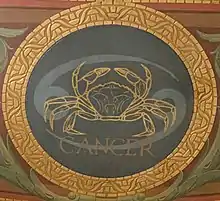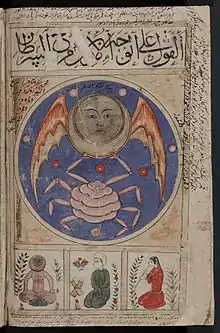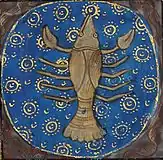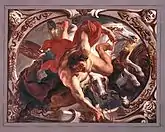Cancer (astrology)
Cancer (♋︎) (Greek: Καρκίνος, romanized: Karkínos, Latin for "crab") is the fourth astrological sign in the zodiac, originating from the constellation of Cancer. It spans from 90° to 120° celestial longitude. Under the tropical zodiac, the Sun transits this area between approximately June 22 and July 22.[2]
| Cancer | |
|---|---|
 | |
| Zodiac symbol | Crab |
| Duration (tropical, western) | June 21 – July 23 (2023, UT1)[1] |
| Constellation | Cancer |
| Zodiac element | Water |
| Zodiac quality | Cardinal |
| Sign ruler | Moon |
| Detriment | Saturn |
| Exaltation | Jupiter |
| Fall | Mars |
| Astrology |
|---|
 |
| Background |
| Traditions |
| Branches |
| Astrological signs |
| Symbols |
In astrology, Cancer is the cardinal sign of the Water trigon, which is made up of Cancer, Pisces, and Scorpio.[3] It is one of the six negative signs, and its ruling planet is the Moon. Though some depictions of Cancer feature a lobster or crayfish,[2] the sign is most often represented by the crab, based on the Karkinos. Cancer's opposite sign is Capricorn.
Background
Cancer is the fourth sign of the zodiac, which the sun enters at the summer solstice in the Northern Hemisphere Those who are born from approximately June 22 to July 22 (depending upon the year) are born under Cancer.[2] Individuals born during these dates, depending on which system of astrology they subscribe to, may be called "Cancerians".[4] Cancer is a northern sign, and its opposite sign is Capricorn.[5][6][7] Cancer is a cardinal sign.
Water is the element associated with Cancer,[8] and, alongside Scorpio and Pisces, it forms the water trigon.[9] The water trigon is one of four elemental trigons in the zodiac, with the other three being fire, earth, and air.[10] When a trigon is influential, it is said to affect changes on earth.[10] Cancer is said to be the house of Neptune and the exaltation of Jupiter, both astronomical bodies over those born under Cancer.[5][6] Its ruling planet is the Moon.[11] Due to the negative associations of the word "Cancer" with the disease of the same name, some astrologers refer to persons born under this sign as "moon children".[12][13]
Divine associations with Cancer in Renaissance astrology are Luna/Diana, both goddesses that represent the Moon, Cancer's ruling planet.[8]
In Hindu astrology, the sign of Cancer is named Karka and its ruler is Moon.[14]
Early history
"Cancer" is an ancient word of Indo-European origin, derived from a root meaning "to scratch."[15] In ancient Egypt, the sign of Cancer was conceived as a scarab beetle, while in Mesopotamia it was represented by a turtle.[15] In each case, the animal representative of the sign was perceived as "pushing" the sun across the heavens, initiating the summer solstice.[15]
Latin cancer is the generic word for 'crab'.[15] According to Greek myth, the symbol of Cancer—often a crab, though sometimes a lobster—is based on the Karkinos (Greek: "Cancer"), a crab crushed under the foot of Heracles, and whose remains were placed in the sky by Hera, forming the Cancer constellation.[4] In Roman variations of the story, it is Juno—Hera's counterpart in Roman mythology—who places the crab in the sky.[16] Naturalist Richard Hinckley Allen, in 1899, deemed Cancer the "most inconspicuous figure in the zodiac," adding that its mythology "apologizes for its being there by the story that when the Crab was crushed by Hercules, for pinching his toes during a contest with the Hydra in the Marsh of Lerna, Juno exalted it to the sky."[16]
In the arts
During the Middle Ages, the zodiacal symbol of Cancer was included in devotional books and incorporated into monumental sculptures.[15] The depiction of Cancer as a crab is most prevalent in Mediterranean and Western European art.[15]
In Dante Alighieri's Paradiso, he makes reference to Cancer, writing:
Thereafterward a light among them brightened,
So that, if Cancer one such crystal had,
Winter would have a month of one sole day.— Dante Alighieri, Paradiso[17]
Cancer is figured in Giovanni Maria Falconetto's 1517 painting, Cancer, as the guardian of the city of Verona.[18] The Cancer symbol is also depicted in Agostino di Duccio's sculpture View of Rimini Under the Sign of Cancer (1450).[19] In Giorgio Vasari's fresco, the Chamber of Fortune, Cancer is represented in the northern compartment of the ceiling, pictured by Diana, holding the moon, along with a crab.[20]
Gallery
 Supplément turc. 242, fol. 14v - Osman, Cancer ca. 1582
Supplément turc. 242, fol. 14v - Osman, Cancer ca. 1582 In the 14th c. Arabic manuscript, Book of Wonders
In the 14th c. Arabic manuscript, Book of Wonders In Llyfr Llyfr Oriau 'De Grey (De Grey Hours), ca. 1390
In Llyfr Llyfr Oriau 'De Grey (De Grey Hours), ca. 1390 In Jacob Jordaens's Les Signes du Zodiaque, ca. 1640
In Jacob Jordaens's Les Signes du Zodiaque, ca. 1640.jpg.webp)
 Mural in the Kupa Synagogue, Kraków, Poland
Mural in the Kupa Synagogue, Kraków, Poland
See also
References
- Astronomical Applications Department 2011.
- "Cancer". Encyclopædia Britannica. 2021. Retrieved February 26, 2021.
- Shoemaker 1904, p. 45.
- "Cancer: Meaning of Cancer". Oxford Dictionaries. Oxford University Press. Archived from the original on April 27, 2020. Retrieved April 28, 2020.
- Smith 1828, p. 64
- Lilly 1835, pp. 14, 60
- Simmonite 1896, p. 17.
- Cheney 2007, p. 54.
- Allen 1899, p. 107
- Harkness 1999, p. 70.
- Cheney 2007, pp. 54–55.
- Merriam 1991, p. 83.
- Algeo & Butcher 2014, p. 238.
- Charak 1996, p. 12.
- Savage, Jessica (June 21, 2016). "June's Zodiac Sign and "Lobster-Like" Crabs". The Index of Medieval Art. Princeton University. Archived from the original on April 27, 2020. Retrieved April 28, 2020.
- Allen 1899, p. 107.
- Allen 1899, p. 109.
- Battistini 2007, p. 47.
- Battistini 2007, p. 46.
- Cheney 2007, p. 50.
Sources
- Algeo, John; Butcher, Carmen Acevedo (2014). The Origins and Development of the English Language (7th ed.). Boston: Wadsworth. ISBN 9781133307273. Retrieved August 27, 2022.
- Allen, Richard Hinckley (1899). The Star-Names and Their Meanings. New York City, New York: G.E. Stechert.
- Astronomical Applications Department (2011). Multiyear Computer Interactive Almanac. 2.2.2. Washington DC: US Naval Observatory. Longitude of Sun, apparent geocentric ecliptic of date, interpolated to find time of crossing 0°, 30°....
- Battistini, Matilde (2007). Astrology, Magic, and Alchemy in Art (A Guide to Imagery). J. Paul Getty Museum. ISBN 978-0-892-36907-2.
- Charak, K.S. (1996). Elements of Vedic Astrology. Vol. 1. Systems Vision. ISBN 9788190100809.
- Cheney, Liana (2007). Giorgio Vasari's Teachers: Sacred & Profane Art. New York City, New York: Peter Lang. ISBN 978-0-820-48813-4.
- Harkness, Deborah E. (1999). John Dee's Conversations with Angels: Cabala, Alchemy, and the End of Nature. Cambridge, England: Cambridge University Press. ISBN 978-0-521-62228-8.
- Lilly, William (1835). An Introduction to Astrology, Rules For the Practice of Horary Astrology [an abstract of Christian astrology]: To Which Are Added, Numerous Emendations, by Zadkiel. Oxford, England: Oxford University.
- The Merriam-Webster New Book of Word Histories. Springfield, Mass.: Merriam-Webster. 1991. ISBN 0877796033. Retrieved August 27, 2022.</ref>
- Shoemaker, Mrs. Mabel (McGeorge) (1904). Astrology. Philadelphia, Pennsylvania: Penn Publishing Company.
- Simmonite, William Joseph (2015) [1896]. Horary Astrology: The Key To Scientific Prediction, Being The Prognostic Astronomer. Andesite Press [Harvard College Library]. ISBN 978-1-296-83282-7.
- Smith, Robert Cross (1828). A Manual of Astrology, by Raphael. Oxford, England: Oxford University.
- Spiller, Jan; McCoy, Karen (1988). Spiritual Astrology: A Path to Divine Awakening. New York City, New York: Simon & Schuster. ISBN 978-1-439-12420-8.
External links
 The dictionary definition of Cancer at Wiktionary
The dictionary definition of Cancer at Wiktionary Media related to Cancer at Wikimedia Commons
Media related to Cancer at Wikimedia Commons- Warburg Institute Iconographic Database (ca 360 medieval and early modern images of Cancer)